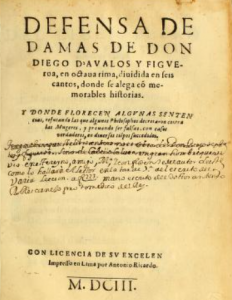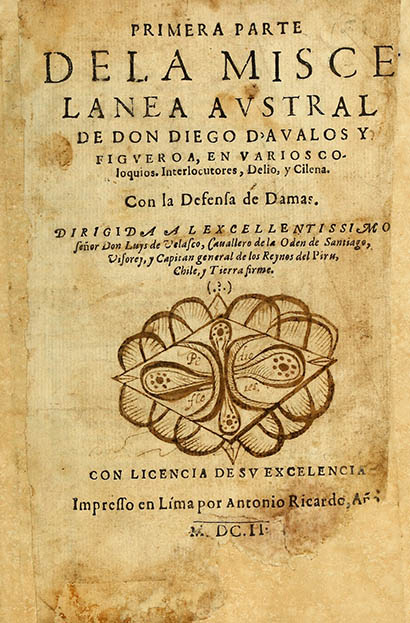
Libraries
Libraries
Primera parte de la Miscelánea austral. Con la defensa de las damas
The miscelánea is a genre that developed with particular force during the Renaissance and was the privileged source of dissemination of humanism due to its quality of transmitter of news, knowledge and theories of knowledge: it taught while delighting. This genre, often written in the vulgar language, allowed the authors to emerge as men of knowledge and to claim a position within the Republic of Letters.
Thus, the Miscelánea austral presents a scholarly dialogue, whose central theme is love and poetry, of a couple walking through a leafy garden: he, Delio, recites a sonnet, celebrating their conjugal happiness and the joy of their life, while she, Cilena, listens to him and responds eloquently. As Sonia V. Rosé (2003) points out: «This scene is not situated in the Peninsula or in Italy, but in the kingdom of Peru; Delio and Cilena are not Petrarca and Laura, but encomenderos and owners of mines; the mountains whose snow they allude to in Petrarchan are not the Provenza mountains, but the Illimani and the Huayna Potosí that watch over the city of La Paz, in the audience of Charcas».

Defensa de damas
The text by Dávalos and Figueroa allows us to observe the process of articulation between the local and the imperial: the poet and the Antarctic Academy create a local, cultural and literary space to develop their activities in the Indies and are inserted in a universal space within the monarchy Hispanic; Furthermore, its content reveals a double movement: the diffusion of Petrarchism and Neoplatonism in the New World and the insertion of American matter in the universal whole.
The work ends with a prose colloquium, the Defensa de damas. Although this text appeared independently, with cover and imprint (Lima, Antonio Ricardo, 1603), it is an integral part of Dávalos’ work due to its content, structure and intention. The relationship between the two works has given rise to much discussion: both Luis Jaime Cisneros and Alicia Colombí-Monguió maintain that it is the last colloquium of the Miscelnea Austral.
Daphne Cornejo
Proyecto Estudios Indianos

